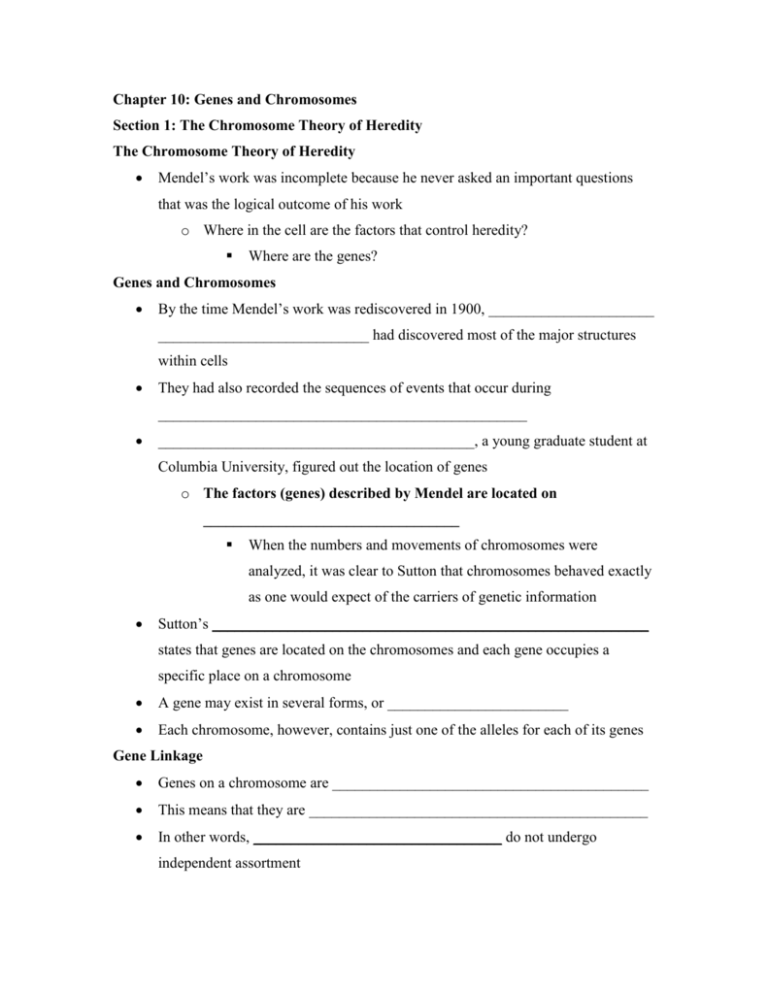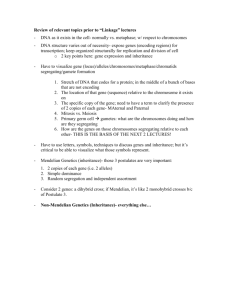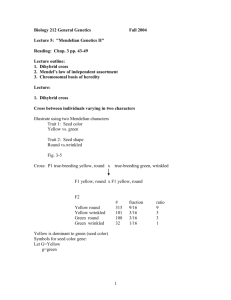Chapter 10: Genes and Chromosomes
advertisement

Chapter 10: Genes and Chromosomes Section 1: The Chromosome Theory of Heredity The Chromosome Theory of Heredity Mendel’s work was incomplete because he never asked an important questions that was the logical outcome of his work o Where in the cell are the factors that control heredity? Where are the genes? Genes and Chromosomes By the time Mendel’s work was rediscovered in 1900, ______________________ ____________________________ had discovered most of the major structures within cells They had also recorded the sequences of events that occur during _________________________________________________ __________________________________________, a young graduate student at Columbia University, figured out the location of genes o The factors (genes) described by Mendel are located on __________________________________ When the numbers and movements of chromosomes were analyzed, it was clear to Sutton that chromosomes behaved exactly as one would expect of the carriers of genetic information Sutton’s __________________________________________________________ states that genes are located on the chromosomes and each gene occupies a specific place on a chromosome A gene may exist in several forms, or ________________________ Each chromosome, however, contains just one of the alleles for each of its genes Gene Linkage Genes on a chromosome are __________________________________________ This means that they are _____________________________________________ In other words, _________________________________ do not undergo independent assortment One of the earliest examples of linked genes was discovered by the American geneticist ________________________________________________ o Morgan studied the tiny fruit fly, ________________________________ ______________________________, which can produce a new generation every ____________________________ Makes Drosophila an ideal organism to study because traits in succeeding generations can be observed relatively quickly The Effects of Gene Linkage Morgan crossed purebred flies that had gray bodies and normal wings with purebred flies that had black bodies and small wings Because gray (G) is dominant over black (g), and normal wings (W) are dominant over small wings (w), all of the F1 flies should have been gray with normal wings (GgWw) o That is exactly what Morgan observed However, when the F1 flies (GgWw) were crossed with black small-winged flies (ggww), Morgan did not observe the expected results If the principle of independent assortment were true for the GgWw x ggww cross, Morgan would have observed ____________ gray normal winged, __________ black small winged, ___________ gray small winged, and __________ black normal winged o Instead, Morgan obtained very different results for the cross Morgan’s actual results differed significantly from those predicted Most gray bodied flies had normal wings, and most black bodied flies had small wings These results indicated that the gene for body color and the gene for wing size were somehow connected, or linked Morgan concluded that the two genes were linked by a physical bond in such a way that they could not assort __________________________________ Linkage Groups As Morgan and his associates studied more and more genes, they found that the genes fell into distinct ___________________________________, or “packages” of genes that always tented to be inherited together The linkage groups, of course, were chromosomes Because homologous chromosomes contain the same genes, there is one linkage group for every homologous pair of chromosomes Crossing-Over Look at the results of the test cross between the GgWw and ggww flies again Although 83% of the flies have gene combinations like their parents, 17% have new combinations The 17% are, in the language of geneticists, ____________________________ – individuals with the combinations of genes Morgan and his associate, _______________________________________, proposed that the linkages could be broken some of the time If two homologous chromosomes were positioned side by side, sections of the two chromosomes might _____________________________________________ o This process would rearrange the genes on the chromosome and produce new linkage groups ___________________________________ Gene Mapping Sturtevant further reasoned that crossing-over occurs _______________________ along the linkage groups, and the distance between two genes determines how often crossing-over occurs between them o If two genes are __________________ together, crossing-over between them is _________________ o If two genes are ___________________________, crossing-over between them is more _______________________ Knowing the frequency with which crossing-over between two genes occurs makes it possible to map the positions of genes on a chromosome Sex Linkage In 1905 ___________________________________ noticed that the cells of the female mealworm contain 20 large chromosomes while those of the male contain 19 large chromosomes and 1 small chromosome These seemingly mismatched chromosomes are the ________________________________________ o Male = __________ o Female = __________ The other chromosomes, are called _______________________________ Sex Determination When female gametes are produced, meiosis separates one of the X chromosomes into each egg cell In the male, meiosis separates the X and Y chromosomes so that ____________ of the sperm cells carry a Y chromosome and _____________ carry an X chromosome When a Y sperm fertilizes and egg, a male (XY) is produced When an X sperm fertilizes an egg, a female (XX) is produced In a sense, the ___________________ is responsible for the sex of its offspring Genes on Sex Chromosomes In addition to determining the sex of an individual, the sex chromosomes carry genes that affect other traits A gene located on one of the sex chromosomes is said to be _____________________________ Several important human genes are located on the X chromosome o ___________________________________ o ___________________________________










